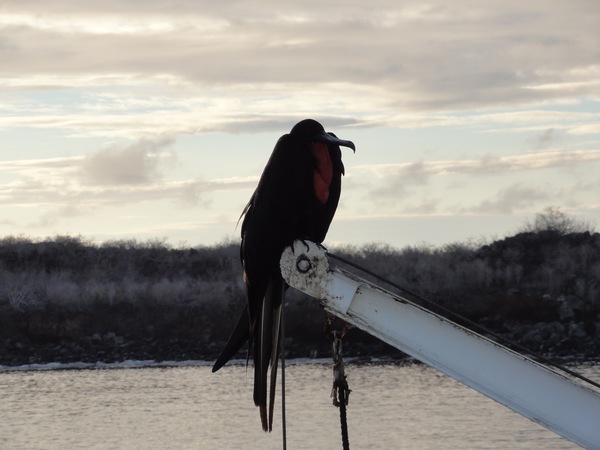"From the presence of the Opuntias and some other plants, the vegetation partakes more of the character of that of America than of any other country."
Charles Darwin, October 3rd, 1835
As we stepped off the plane on San Cristobal, we were greeted with a wave of heat, humidity, and intense equatorial sunlight. As we looked around at the vegetation and terrain, it became evident that Darwin was right. Formed by volcanic activity over the past five million years, the Galapagos seem more desert-like than tropical, as many people think. The lower elevations are arid and feature smaller, shrub-like vegetation and cacti, while some of the higher elevations have vegetation adapted for a more moist environment.
Of our five days spent in the archipelago, the first three were spent aboard the Galaven, an unexpectedly luxurious yacht that would take us to various locations around the islands. Starting at San Cristobal, we also visited Espanola, Santa Fe, South Plaza, and Isabela in the subsequent days. For the final two nights in the Galapagos, students stayed in the homes of families on Isabela. Homestay activities varied quite a bit between families, some members going shopping and others attending local soccer matches.
Snorkeling
One of the highlights of our time in the Galapagos was a series of three snorkeling excursions. The first was along the cliffs of Gardner Islet, a small island near Espanola. Here we were introduced to many tropical fish, seabirds, and some of us swam with the playful Galapagos Sea Lions that were nearby. The second snorkel adventure was in a small bay of Santa Fe. This trip provided more diversity than we could have imagined. It began with colorful tropical fish and more sea lions. Soon, we encountered several rays stirring up sand on the bottom of the bay. As we neared the sandy beach, we were surprised and pleased, to see three Whitetip Reef Sharks dwelling near the rocks (they were soon driven off by a group of sea lions - while sharks are generally faster, sea lions are far more maneuverable). And as if this wasn't enough, we capped off our time in the water by swimming with a Galapagos Sea Turtle (and many more fish). Our third and final snorkeling experience was in a bay off of Isabela. Though the abundance and diversity did not seem as high as Santa Fe, some members of the group had the opportunity to swim with a marine iguana, observe an octopus, and follow another sea turtle as it fed.
Wildlife and Ecology
Sea Lions were some of the first organisms to greet us upon our arrival in the Galapagos, lying all over the boats and docks that we visited on our first night, and fishing alongside and underneath the Galaven for the 3 days that we traveled in it. While you might know that Sea Lions form colonies on beaches, each section of the beach guarded by an alpha male, the alphaship actually trades hands fairly frequently (every few days to 2 weeks). It's a very energy costly job, and you can see how long the current alpha has defended his territory by his weakening voice and slowing pace. Unlike in true lions, when the alphaship trades hands, the new leader does not murder infants. That being said, our guides gave us express advice to not mimic their calls when in the alpha males' territories (some of use had to part ranks to allow an alpha male to chase a juvenile male out of the colony).
We met with two species of iguana over the course of our Galapagoan adventures, occupying very different niches. The first we met was the marine iguana, a strange blackish lizard up to 4 feet in length. Unique among lizards, it dives in cold water to feed on algae (a very risky business, as they are dependent on external warmth for the energy to move). While they can remain submerged for extended periods of time (Darwin records an individual alive and strong after an hour of attempted drowning), they are vulnerable to predation by sharks during this time.
The second species was the land iguana, and it leads a far safer life nowadays. Ever since the death of most of their apex predator, the Galapagos Hawk, during the 1950s, their populations have been flourishing, to the extent of altering vegetation patterns on the island (there are now fewer giant Opuntia cacti, favored by the Galapagos Giant Tortoise for food). However, on some islands, they are suffering from overpopulation, and need to defend areas of food or die of starvation (the fate of many of the elderly and injured land iguanas). However, a project is underway to reintroduce the Galapagos Hawk, which may lead to a reduction in population and an increase of quality of living.
Another iconic organism we became well acquainted with during our stay was the Galapagos Giant Tortoise. Tortoise populations have been decimated over the past 200 years due to hunting by pirates, predation of young by introduced species (rats, cats, dogs, etc.), and destruction of their habitats. We visited two tortoise growth centers and learned about the conservations of the eleven endemic species in the Galapagos. These centers facilitate reproduction and introduce juvenile individuals back into their natural habitats when old enough. We were able to observe many of these amazing creatures, and their appearance certainly merits the name - males can weigh up to 300 kg (females tend to be significantly smaller).















